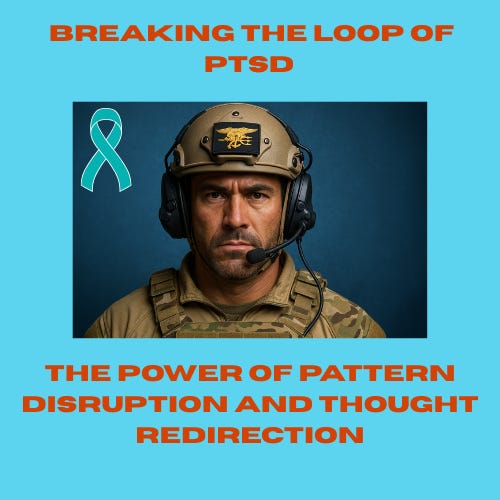The Power of Pattern Interruption and Thought Redirection
By Dr. Ron Campbell | Psychologist | Trauma Strategist | Veteran Advocate
The human brain loves predictability. It thrives on routines, habits, and subconscious loops, many of which were created not for thriving but for surviving. For those battling PTSD, these patterns are not just habits; they are deeply ingrained survival responses. They were once lifesaving. Now, they often sabotage peace, clarity, and relationships.
That’s where pattern disruption comes in:
It’s not just a psychological technique; it’s a combat-tested tool used by elite warriors like Navy SEALs, trauma therapists, and high-performance coaches alike. And it can help you reclaim your life.
What Is Pattern Disruption?
Pattern Disruption is the practice of breaking the brain’s automatic response system.
Imagine a looped soundtrack of fear, shame, or emotional shutdown playing over and over in your mind. Pattern interruption hits pause and lets you change the track.
It works because it disrupts the default neural pathway, often triggered by trauma or chronic stress, and makes space for a different choice. When you intervene at the moment of reaction, you open a window for redirection and healing.
Navy SEALs are trained to use rapid pattern interrupt techniques to override panic reflexes, regulate breathing, and make mission-critical decisions under pressure. The same principle can be applied to civilian life and trauma recovery.
Why It Works?
The brain forms neural shortcuts—quick-fire responses based on experience. When trauma is involved, these shortcuts often lead to survival behaviors: hypervigilance, rage, avoidance, panic, or dissociation.
PTSD hardwires these reactions into your nervous system, creating automatic, unstoppable responses. However, you can interrupt them. You can reset them.
Pattern interruption works because of neuroplasticity, the brain’s ability to change. When you disrupt the old response and introduce a new one, you're rewiring your brain. Over time, the old path weakens, and the new path strengthens.
Even more powerful: many pattern interrupts stimulate the vagus nerve, which helps regulate your parasympathetic nervous system, the part responsible for calm, clarity, and emotional balance.
10 Quick Pattern Disruptors
Use these to interrupt automatic reactions—especially during PTSD flashbacks, panic attacks, or emotional flooding:
Snap a rubber band on your wrist, a tactile jolt that re-centers your awareness.
Name five things you see, four you feel, three you hear, two you smell, and one you taste. It engages all senses to ground the nervous system.
Switch your environment, stand up, change rooms, or leave for fresh air.
Clap your hands loudly – triggers an audio-physical break.
Ten deep, slow breaths from your abdomen will calm your system and activate your vagus nerve.
Speak your emotion aloud: “I feel overwhelmed, but I’m safe now.”
Play uplifting or soothing music: it resets the emotional atmosphere.
Ask yourself, “What do I want to feel right now?” – refocuses your mental state.
Splash cold water on your face: mimics the Navy SEAL "cold water dive reflex" and resets the nervous system.
Laughing, humming, or making a silly noise breaks the intensity and shifts brain chemistry.
These tools aren't gimmicks—they're gateways to regaining control when PTSD hijacks your system.
Redirection: After the Break
Interruption alone isn't enough. You must follow up with redirection: choosing a new thought, belief, or behavior that rewires the brain and empowers healing.
Instead of reacting with fear or shame, say:
“This response doesn’t define me. I’m healing. I’m choosing peace.”
Instead of spiraling into panic, say:
“I’ve been here before. I made it through. I can breathe. I can choose calm.”
With repetition, this becomes more than a coping tool; it becomes your new reality.
Final Thought
Whether you’re a combat veteran, a first responder, or someone silently struggling with PTSD or emotional burnout, hear this:
You are not weak.
You are not broken.
Your brain is doing what it was trained to do.
Now, it’s time to retrain it.
Pattern disruption is not just a clinical technique; it’s a reclaiming of your power.
And with every disruption and redirection, you take another step away from survival mode and into restoration.
Need Help Creating Your Interrupt-and-Redirect Strategy?
If you’re battling PTSD, anxiety, or emotional shutdown, I can help you build the tools to rewire your responses, reset your vagus nerve, and rediscover peace. Together, we can reshape your mind and restore clarity to your daily life.
Let’s break the cycle together.
2025© www.soundthetrumpet.org







